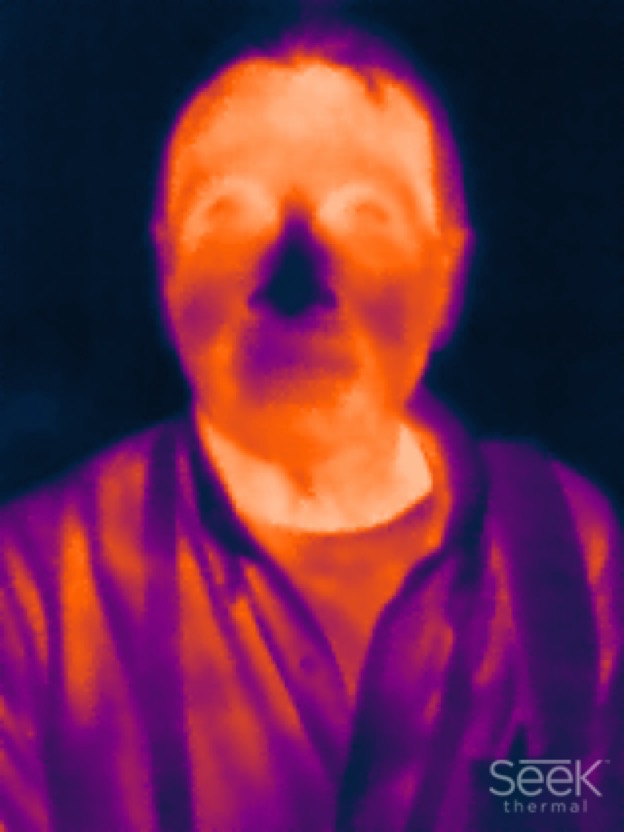 How Much Wood?
How Much Wood?
The big storm that came through New York City in January, preceded by dire warnings that had our neighbors cleaning out the shelves of the local markets, turned out to be just another snowstorm. Having survived multiple blizzards in NYC over the past 72 years (not to mention Hurricane Sandy), I don’t find two feet of snow impressive anymore.
Both Punxatawney Phil and his competition, our local hero Staten Island Chuck, have predicted an early spring. Feels that way right now, though I doubt that winter’s over yet.
The current Chuck survived his February 2 encounter with New York State Lt. Governor Kathy Hochul and a delegate from the mayor’s office, unlike his predecessor, who died from internal injuries after Mayor Bill de Blasio dropped him in 2014. (You may think Chuck — real name Charles G. Hogg — lives a cushy life, but it ain’t risk-free. Incidentally, the groundhog fatally mishandled by Hizzoner was actually a female named Charlotte; the Staten Island Zoo maintains a deep bench for this annual extravaganza.)
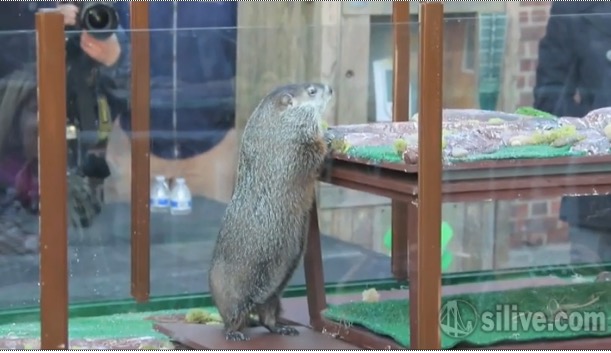
Staten Island Chuck prognosticates, Feb. 2, 2016, SI Live, screenshot
Since then we have had a mix of alternately mild and frigid weather, several more light snows, several downpour. We have had “the coldest February in 81 years, and the third-coldest in the city’s history.” Ten days ago it felt arctic; right now it feels like early spring. Our confused daffodils have poked their leaves above ground. We share the perplexity of our resident birds and squirrels.
(Note: The above portrait of me was made at a tech expo in New York on June 24, 2015 by Seek Thermal Image rep Brent LaSala, using Seek’s app on an iPhone 6, running iOS 8.3.)
Ads They Have Lived to Regret Dept.
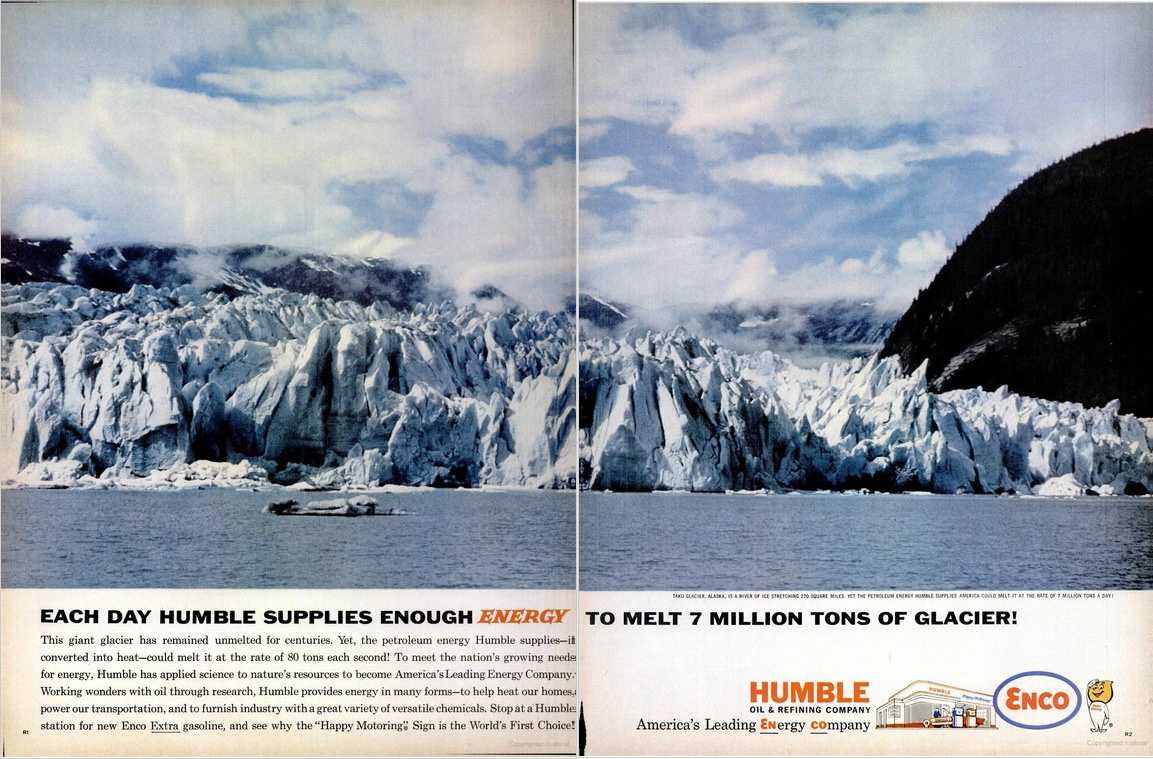
Humble / Enco ad, Taku Glacier, Alaska, from LIFE, February 2, 1962, pp. R1-R2
The above ad, a two-page spread celebrating the power of Humble / Enco (which would become ExxonMobil), appeared in LIFE magazine on February 2, 1962, almost exactly 54 years ago. Its headine boasts that “Each Day Humble Supplies Enough Energy to Melt 7 Million Tons of Glacier!” The ad copy below elaborates:
“This giant glacier has remained unmelted for centuries. Yet, the petroleum energy Humble supplies — if converted into heat — could melt it at the rate of 80 tons each second! … Working wonders with oil through research, Humble provides energy in many forms — to help heat our homes, power our transportation, and to furnish industry with a great variety of versatile chemicals.”
Taku Glacier, largest in the Juneau, Alaska icefield, shown in the photo, has survived global warming so far. And one could argue that the heads of ExxonMobil didn’t yet know about the relationship between fossil fuels and climate change; they wouldn’t learn of that until 1977. (When they would promptly bury the evidence and start perverting the science that provided it.)
Now, of course, investigations of ExxonMobil already proceed at the state level in New York and California, while both Bernie Sanders and (following his lead) Hillary Clinton have called for federal investigations — all relating to the corporation’s involvement in the climate-change denial movement vis-a-vis what it has known from it own scientists from decades.
Things We Wouldn’t Know without Lenses Dept.
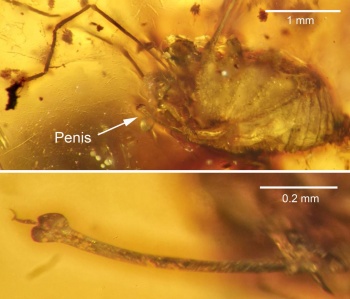
Harvestman in amber, courtesy The Science of nature
This story briefly stirred up a lot of online buzz — most of it lubricious (if commentary about an arachnid’s erection can qualify as such): “Ancient Male Spider Frozen ‘Stiff’ in Amber for 100 Million Years.” But then what would you expect in a culture which refers to women’s genitalia and breasts as “lady bits”?
Anyhow, credit microscopes and cameras for making the invisible visible once again, allowing us to contemplate this example of Halitherses grimaldii from Myanmar and imagine his disappointment.
While commenting on Harvestman’s humongous hard-on, certainly worthy of respect, one thing nobody seems to consider concerns staying power. Amber is fossilized sap, and sap doesn’t flood over anything. It oozes. Slowly. So it took a long time (we’re talking days) for it to cover and smother this little guy, who kept it up the whole time. That’s male optimism for you.
Nature vs. Culture
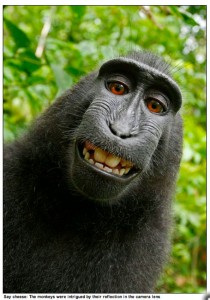
Macaque self-portrait, Indonesia, 2011, as captioned by the London Daily Mail.
Sad news for those seeking to extend the concept of animal rights: “Monkey Cannot Own Copyright To Viral Selfie, Says Federal Judge.” In a decision announced on January 7 of this year, U.S. District Judge William Orrick ruled that “while Congress and the president can extend the protection of law to animals as well as humans, there is no indication that they did so in the Copyright Act. … This is an issue for Congress and the president. If they think animals should have the right of copyright they’re free, I think, under the Constitution, to do that.”
For those coming late to this story, on which I’ve reported previously, in 2011 a crested macaque monkey named Naruto, a native of Sulawesi, Indonesia, picked up British nature photographer David Slater’s camera to make a series of selfies. These quickly went viral when published, with assorted print and online platforms using them without Slater’s permission and Slater claiming copyright violation.
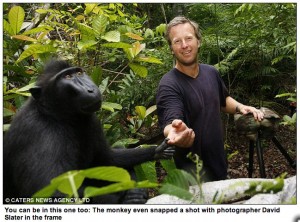
David Slater with macaque, primate photographer unidentified, Indonesia, 2011, as captioned by the London Daily Mail.
The U.S. Copyright Office refuses to register copyright for any works “produced by nature, animals or plants,” thus placing them automatically in the public domain upon creation. In this regard, the U.S. copyright law conforms to international standards.
As of this writing, it’s not clear whether Slater will pursue further his claim to copyright, nor whether People for the Ethical Treatment of Animals (PETA), which filed the suit seeking copyright on Naruto’s behalf, will elect to appeal this decision to a higher court.
Eye of the Beholder
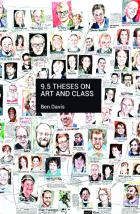 Count me a Ben Davis fan. Not because this art critic helps me engage with and understand individual works of art or bodies of work; normally he addresses those only in passing, leaving what I think of textual criticism — the close attention to and analysis of the stuff that artists make and do — to others. But he excels at contextual criticism, especially the economics and politics of the art world and the discourse about art. And he does so with remarkable verbal panache; the man can write.
Count me a Ben Davis fan. Not because this art critic helps me engage with and understand individual works of art or bodies of work; normally he addresses those only in passing, leaving what I think of textual criticism — the close attention to and analysis of the stuff that artists make and do — to others. But he excels at contextual criticism, especially the economics and politics of the art world and the discourse about art. And he does so with remarkable verbal panache; the man can write.
Take, for example, his recent Artnet piece, “David Brooks Gets Bizarre in His Latest Essay on Beauty,” in which he deconstructs “When Beauty Strikes,” a piece of sappy, ill-informed balderdash by the sappy, ill-informed New York Times columnist. One could argue that tearing apart this bit of sentimental, retrograde nonsense — in which Brooks never troubles himself to define the phenomenon he calls “beauty” — qualifies as shooting fish in a barrel. But, given that Brooks has at his disposal and uses for this purpose one of the English-speaking world’s most influential platforms, it only gets what it deserves.
If you enjoy Davis on this subject, check out his other Artnet essays, and his book 9.5 Theses on Art and Class (Haymarket Books, 2013).
Criticism Lite
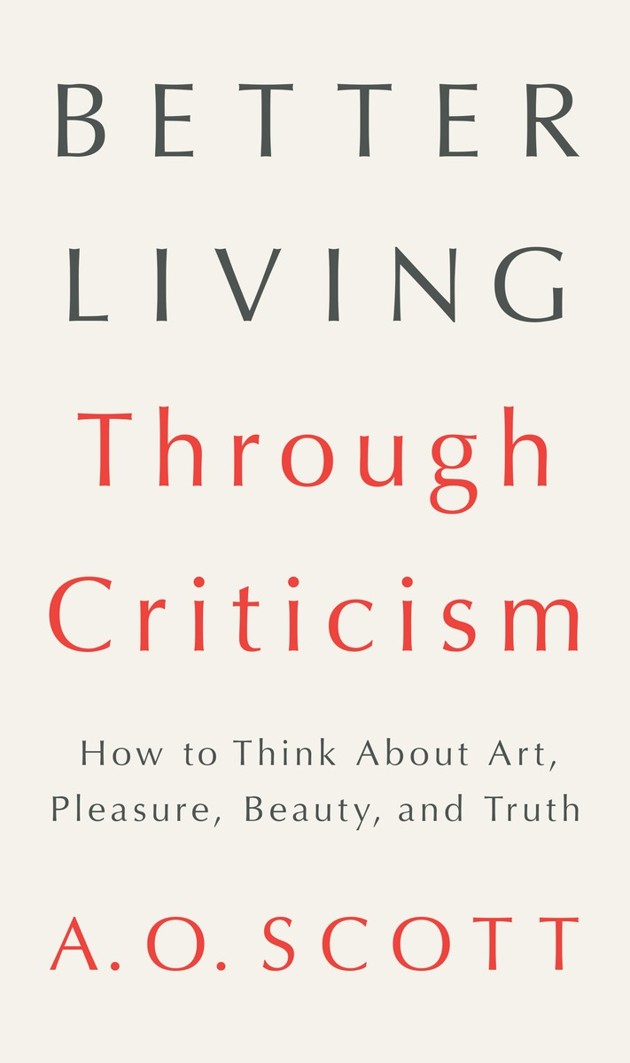 You may also enjoy Leon Wieseltier’s “A. O. Scott, Critic Without a Cause,” an elegant, scathing dissection of the New York Times film critic’s new book, Better Living Through Criticism: How to Think About Art, Pleasure, Beauty, and Truth. (you’ll find a selection from it, “Everybody’s a Critic. And That’s How It Should Be,” here.)
You may also enjoy Leon Wieseltier’s “A. O. Scott, Critic Without a Cause,” an elegant, scathing dissection of the New York Times film critic’s new book, Better Living Through Criticism: How to Think About Art, Pleasure, Beauty, and Truth. (you’ll find a selection from it, “Everybody’s a Critic. And That’s How It Should Be,” here.)
The subtitle of Scott’s book gives its goal away; telling its readers “how to think” about some stuff. I can’t imagine having the effrontery to do that. But, from the excerpt in the Times, Scott solves that problem by the simple expedient of vapidly endorsing his readers’ vague, uninformed opinionating as somehow equivalent to critical thinking.
Perhaps that’s because it’s certainly equivalent to Scott’s own writing on film. Wieseltier describes this book as “a triumph of the nonaffiliated and the noncommittal.” He disdains Scott for the same fundamental reason I find him and so many critics of all media (including, alas, most of my colleagues) unreadable: the absence of commitment to anything resembling a clearly articulated, closely reasoned, and challenging position.
If you don’t have convictions — or lack the proverbial courage those can require when enunciated in public — you can’t really call yourself a critic. I’d argue — and I think Wieseltier would too — that if a critic hasn’t staked out at least one controversial position over a given year, taken one stand that involves nay-saying and risk, his or her critical license should get revoked.
Wieseltier sums up Scott’s avoidance of that obligation thus:
“The interest of Scott’s book lies … in its exemplification of our moment in American culture and American cultural journalism. It is an accurate document of the discourse of ‘takes.’ … A take is an opinion that has no aspiration to a belief, an impression that never hardens into a position. Its lightness is its appeal. It is provisional, evanescent, a move in a game, an accredited shallowness, a bulwark against a pause in the conversation. A take is expected not to be true but to be interesting, and even when it is interesting it makes no troublesome claim upon anybody’s attention. Another take will quickly follow, and the silence that is a mark of perplexity, of research and reflection, will be mercifully kept at bay. A take asks for no affiliation. It requires no commitment.”
At this blog I’ve written about both the highbrow rationale for uninformed opinionation (in the series “How to Talk Through Your Hat”) and the lowbrow version thereof (in the series “Forumization and Its Malcontent”). Scott seems to have convinced himself — and hopes to convince his middlebrow book’s middlebrow readers — that swapping attitudes toward this or that artwork over beer and wings constitutes “doing criticism,” when it adds up to nothing more than social posturing.
My rule of thumb: If it hasn’t cost you anything, it’s not principle, it’s just attitude. By the same token, if nothing’s at stake it ain’t criticism, merely (in Wieseltier’s felicitous usage) a “take,” which you can change the next day without losing face.
Weasels, Encore …
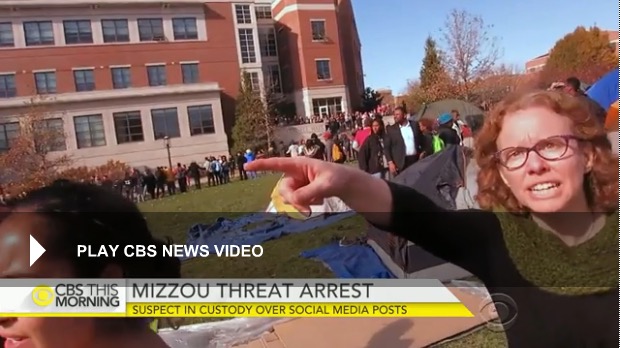
Melissa Click, Univ. of Missouri, 11-9-15, CBS screenshot
I have noted previously the growing tendency of people to claim that one or another of their actions does not represent them — presumably invoking amnesia, or multiple-personality disorder, or “Manchurian Candidate” brainwashing, or alien abduction to explain the fact that someone occupying their body said or did whatever an audio or video recording proves actually happened.
Joining the club: University of Missouri assistant professor of communication Melissa Click, who became infamous in November 2015 for requesting “some muscle” to eject a journalist from a public space as he covered a demonstration. According to a February 13, 2016 report in the university’s newspaper, “In an interview Friday with the Missourian, Click acknowledged she made a mistake in November and said her actions did not represent who she is. And that she is battling to get back to where and who she was.” (Emphasis mine.) Add the refusal to own her words and deeds to the list of this weasel’s offenses.
[Note: The Univ. of Missouri terminated Click’s employment on February 25, 2016. — A. D. C.]
Short Shrift
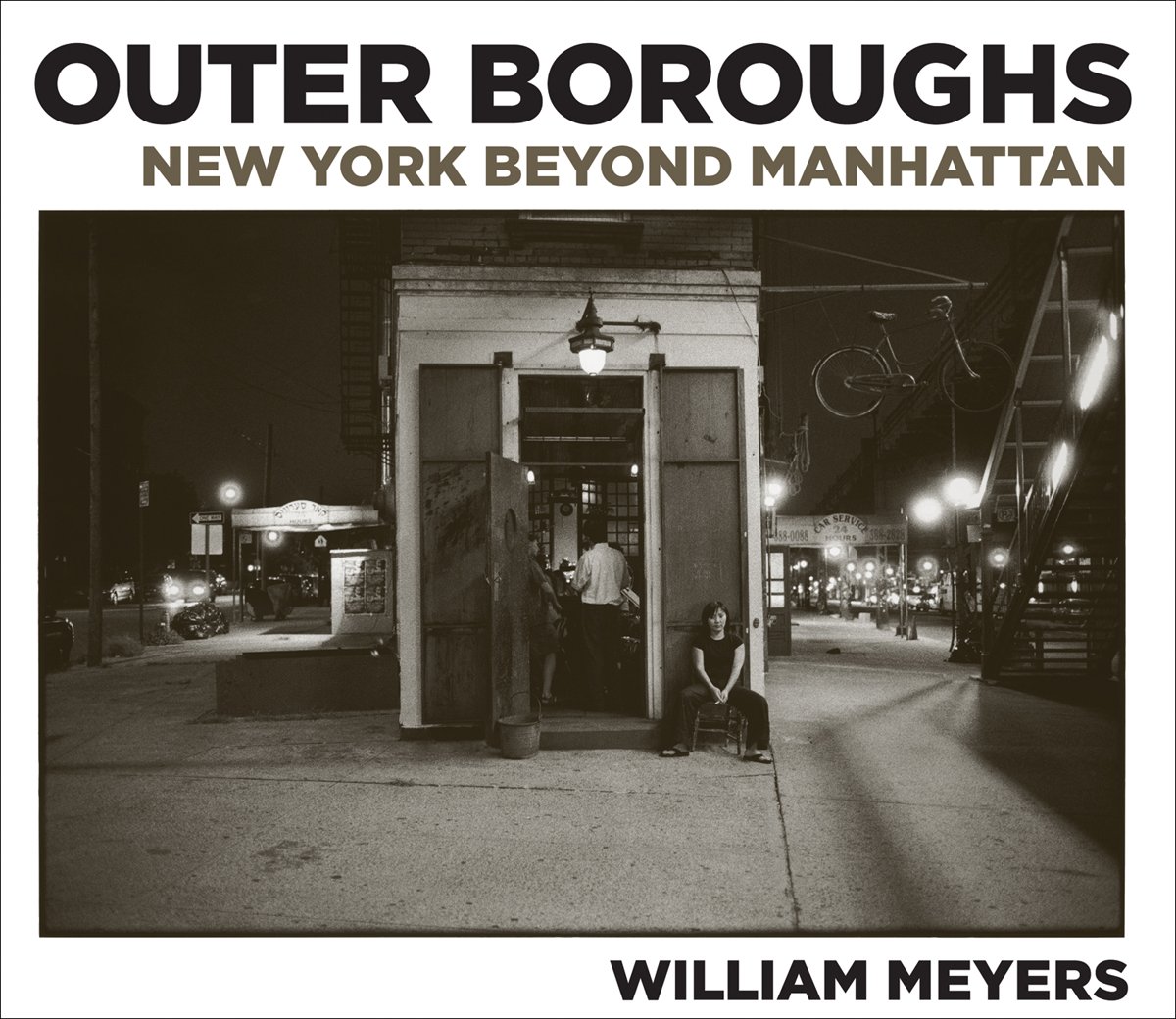 Browsing in the Strand bookstore recently, I came across Outer Boroughs: New York Beyond Manhattan (Damiani, 2014), by William Meyers, hitherto unknown to me. I appreciate its premise — that the boroughs of the metropolis other than Manhattan deserve some attention. Imagine my disappointment upon discovering that Meyers made only 4 of its 86 images on Staten Island — all within a single day, I’ll venture, since they all appear to have been made in the same season and describe public spaces easily accessible via a single ride on the Staten Island Rapid Transit elevated train.
Browsing in the Strand bookstore recently, I came across Outer Boroughs: New York Beyond Manhattan (Damiani, 2014), by William Meyers, hitherto unknown to me. I appreciate its premise — that the boroughs of the metropolis other than Manhattan deserve some attention. Imagine my disappointment upon discovering that Meyers made only 4 of its 86 images on Staten Island — all within a single day, I’ll venture, since they all appear to have been made in the same season and describe public spaces easily accessible via a single ride on the Staten Island Rapid Transit elevated train.
A missed opportunity to give what Wu Tang Clan calls “The Rock” its due. High time for someone to do the serious photo book that the island deserves. Most likely it won’t come from an outsider like Meyers, who clearly shares the widespread dismissive attitude toward this place and its half-million inhabitants (yours truly included).
•
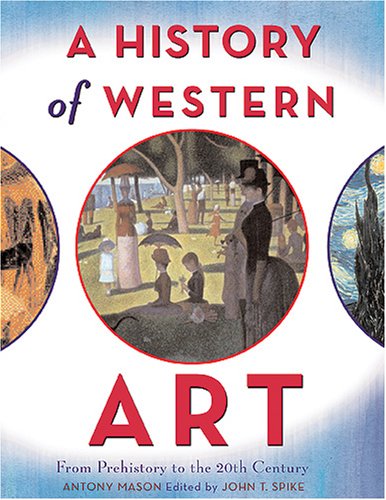 And as long as I’m on the subject of shrift, that same day in Strand, looking through Antony Mason’s A History of Western Art (Abrams, 2007), I found photography mentioned just once — in a chapter titled “New Media: New Directions” (p. 122), illustrated with a Cindy Sherman, the medium mentioned in a one-paragraph caption thereto. Some things never change.
And as long as I’m on the subject of shrift, that same day in Strand, looking through Antony Mason’s A History of Western Art (Abrams, 2007), I found photography mentioned just once — in a chapter titled “New Media: New Directions” (p. 122), illustrated with a Cindy Sherman, the medium mentioned in a one-paragraph caption thereto. Some things never change.
Small Potato(es), Highly Priced
Après Peter Lik, le deluge: “Kevin Abosch sells photograph of potato for $1.5 million.” I have nothing to say about this that I haven’t said before.
•
 Special offer: If you want me to either continue pursuing a particular subject or give you a break and (for one post) write on a topic — my choice — other than the current main story, make a donation of $50 via the PayPal widget below, indicating your preference in a note accompanying your donation. I’ll credit you as that new post’s sponsor, and link to a website of your choosing. Include a note with your snail-mail address (or email it to me separately) for a free signed copy of my 1995 book Critical Focus!
Special offer: If you want me to either continue pursuing a particular subject or give you a break and (for one post) write on a topic — my choice — other than the current main story, make a donation of $50 via the PayPal widget below, indicating your preference in a note accompanying your donation. I’ll credit you as that new post’s sponsor, and link to a website of your choosing. Include a note with your snail-mail address (or email it to me separately) for a free signed copy of my 1995 book Critical Focus!
Cabin Fever 2016: Bits & Pieces (1)
The big storm that came through New York City in January, preceded by dire warnings that had our neighbors cleaning out the shelves of the local markets, turned out to be just another snowstorm. Having survived multiple blizzards in NYC over the past 72 years (not to mention Hurricane Sandy), I don’t find two feet of snow impressive anymore.
Both Punxatawney Phil and his competition, our local hero Staten Island Chuck, have predicted an early spring. Feels that way right now, though I doubt that winter’s over yet.
The current Chuck survived his February 2 encounter with New York State Lt. Governor Kathy Hochul and a delegate from the mayor’s office, unlike his predecessor, who died from internal injuries after Mayor Bill de Blasio dropped him in 2014. (You may think Chuck — real name Charles G. Hogg — lives a cushy life, but it ain’t risk-free. Incidentally, the groundhog fatally mishandled by Hizzoner was actually a female named Charlotte; the Staten Island Zoo maintains a deep bench for this annual extravaganza.)
Staten Island Chuck prognosticates, Feb. 2, 2016, SI Live, screenshot
Since then we have had a mix of alternately mild and frigid weather, several more light snows, several downpour. We have had “the coldest February in 81 years, and the third-coldest in the city’s history.” Ten days ago it felt arctic; right now it feels like early spring. Our confused daffodils have poked their leaves above ground. We share the perplexity of our resident birds and squirrels.
(Note: The above portrait of me was made at a tech expo in New York on June 24, 2015 by Seek Thermal Image rep Brent LaSala, using Seek’s app on an iPhone 6, running iOS 8.3.)
Ads They Have Lived to Regret Dept.
Humble / Enco ad, Taku Glacier, Alaska, from LIFE, February 2, 1962, pp. R1-R2
The above ad, a two-page spread celebrating the power of Humble / Enco (which would become ExxonMobil), appeared in LIFE magazine on February 2, 1962, almost exactly 54 years ago. Its headine boasts that “Each Day Humble Supplies Enough Energy to Melt 7 Million Tons of Glacier!” The ad copy below elaborates:
“This giant glacier has remained unmelted for centuries. Yet, the petroleum energy Humble supplies — if converted into heat — could melt it at the rate of 80 tons each second! … Working wonders with oil through research, Humble provides energy in many forms — to help heat our homes, power our transportation, and to furnish industry with a great variety of versatile chemicals.”
Taku Glacier, largest in the Juneau, Alaska icefield, shown in the photo, has survived global warming so far. And one could argue that the heads of ExxonMobil didn’t yet know about the relationship between fossil fuels and climate change; they wouldn’t learn of that until 1977. (When they would promptly bury the evidence and start perverting the science that provided it.)
Now, of course, investigations of ExxonMobil already proceed at the state level in New York and California, while both Bernie Sanders and (following his lead) Hillary Clinton have called for federal investigations — all relating to the corporation’s involvement in the climate-change denial movement vis-a-vis what it has known from it own scientists from decades.
Things We Wouldn’t Know without Lenses Dept.
Harvestman in amber, courtesy The Science of nature
This story briefly stirred up a lot of online buzz — most of it lubricious (if commentary about an arachnid’s erection can qualify as such): “Ancient Male Spider Frozen ‘Stiff’ in Amber for 100 Million Years.” But then what would you expect in a culture which refers to women’s genitalia and breasts as “lady bits”?
Anyhow, credit microscopes and cameras for making the invisible visible once again, allowing us to contemplate this example of Halitherses grimaldii from Myanmar and imagine his disappointment.
While commenting on Harvestman’s humongous hard-on, certainly worthy of respect, one thing nobody seems to consider concerns staying power. Amber is fossilized sap, and sap doesn’t flood over anything. It oozes. Slowly. So it took a long time (we’re talking days) for it to cover and smother this little guy, who kept it up the whole time. That’s male optimism for you.
Nature vs. Culture
Macaque self-portrait, Indonesia, 2011, as captioned by the London Daily Mail.
Sad news for those seeking to extend the concept of animal rights: “Monkey Cannot Own Copyright To Viral Selfie, Says Federal Judge.” In a decision announced on January 7 of this year, U.S. District Judge William Orrick ruled that “while Congress and the president can extend the protection of law to animals as well as humans, there is no indication that they did so in the Copyright Act. … This is an issue for Congress and the president. If they think animals should have the right of copyright they’re free, I think, under the Constitution, to do that.”
For those coming late to this story, on which I’ve reported previously, in 2011 a crested macaque monkey named Naruto, a native of Sulawesi, Indonesia, picked up British nature photographer David Slater’s camera to make a series of selfies. These quickly went viral when published, with assorted print and online platforms using them without Slater’s permission and Slater claiming copyright violation.
David Slater with macaque, primate photographer unidentified, Indonesia, 2011, as captioned by the London Daily Mail.
The U.S. Copyright Office refuses to register copyright for any works “produced by nature, animals or plants,” thus placing them automatically in the public domain upon creation. In this regard, the U.S. copyright law conforms to international standards.
As of this writing, it’s not clear whether Slater will pursue further his claim to copyright, nor whether People for the Ethical Treatment of Animals (PETA), which filed the suit seeking copyright on Naruto’s behalf, will elect to appeal this decision to a higher court.
Eye of the Beholder
Take, for example, his recent Artnet piece, “David Brooks Gets Bizarre in His Latest Essay on Beauty,” in which he deconstructs “When Beauty Strikes,” a piece of sappy, ill-informed balderdash by the sappy, ill-informed New York Times columnist. One could argue that tearing apart this bit of sentimental, retrograde nonsense — in which Brooks never troubles himself to define the phenomenon he calls “beauty” — qualifies as shooting fish in a barrel. But, given that Brooks has at his disposal and uses for this purpose one of the English-speaking world’s most influential platforms, it only gets what it deserves.
If you enjoy Davis on this subject, check out his other Artnet essays, and his book 9.5 Theses on Art and Class (Haymarket Books, 2013).
Criticism Lite
The subtitle of Scott’s book gives its goal away; telling its readers “how to think” about some stuff. I can’t imagine having the effrontery to do that. But, from the excerpt in the Times, Scott solves that problem by the simple expedient of vapidly endorsing his readers’ vague, uninformed opinionating as somehow equivalent to critical thinking.
Perhaps that’s because it’s certainly equivalent to Scott’s own writing on film. Wieseltier describes this book as “a triumph of the nonaffiliated and the noncommittal.” He disdains Scott for the same fundamental reason I find him and so many critics of all media (including, alas, most of my colleagues) unreadable: the absence of commitment to anything resembling a clearly articulated, closely reasoned, and challenging position.
If you don’t have convictions — or lack the proverbial courage those can require when enunciated in public — you can’t really call yourself a critic. I’d argue — and I think Wieseltier would too — that if a critic hasn’t staked out at least one controversial position over a given year, taken one stand that involves nay-saying and risk, his or her critical license should get revoked.
Wieseltier sums up Scott’s avoidance of that obligation thus:
“The interest of Scott’s book lies … in its exemplification of our moment in American culture and American cultural journalism. It is an accurate document of the discourse of ‘takes.’ … A take is an opinion that has no aspiration to a belief, an impression that never hardens into a position. Its lightness is its appeal. It is provisional, evanescent, a move in a game, an accredited shallowness, a bulwark against a pause in the conversation. A take is expected not to be true but to be interesting, and even when it is interesting it makes no troublesome claim upon anybody’s attention. Another take will quickly follow, and the silence that is a mark of perplexity, of research and reflection, will be mercifully kept at bay. A take asks for no affiliation. It requires no commitment.”
At this blog I’ve written about both the highbrow rationale for uninformed opinionation (in the series “How to Talk Through Your Hat”) and the lowbrow version thereof (in the series “Forumization and Its Malcontent”). Scott seems to have convinced himself — and hopes to convince his middlebrow book’s middlebrow readers — that swapping attitudes toward this or that artwork over beer and wings constitutes “doing criticism,” when it adds up to nothing more than social posturing.
My rule of thumb: If it hasn’t cost you anything, it’s not principle, it’s just attitude. By the same token, if nothing’s at stake it ain’t criticism, merely (in Wieseltier’s felicitous usage) a “take,” which you can change the next day without losing face.
Weasels, Encore …
Melissa Click, Univ. of Missouri, 11-9-15, CBS screenshot
I have noted previously the growing tendency of people to claim that one or another of their actions does not represent them — presumably invoking amnesia, or multiple-personality disorder, or “Manchurian Candidate” brainwashing, or alien abduction to explain the fact that someone occupying their body said or did whatever an audio or video recording proves actually happened.
Joining the club: University of Missouri assistant professor of communication Melissa Click, who became infamous in November 2015 for requesting “some muscle” to eject a journalist from a public space as he covered a demonstration. According to a February 13, 2016 report in the university’s newspaper, “In an interview Friday with the Missourian, Click acknowledged she made a mistake in November and said her actions did not represent who she is. And that she is battling to get back to where and who she was.” (Emphasis mine.) Add the refusal to own her words and deeds to the list of this weasel’s offenses.
[Note: The Univ. of Missouri terminated Click’s employment on February 25, 2016. — A. D. C.]
Short Shrift
A missed opportunity to give what Wu Tang Clan calls “The Rock” its due. High time for someone to do the serious photo book that the island deserves. Most likely it won’t come from an outsider like Meyers, who clearly shares the widespread dismissive attitude toward this place and its half-million inhabitants (yours truly included).
•
Small Potato(es), Highly Priced
Après Peter Lik, le deluge: “Kevin Abosch sells photograph of potato for $1.5 million.” I have nothing to say about this that I haven’t said before.
•